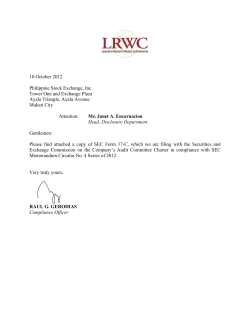
LC PDF Printout SEC Congressional Testimony â Part 3
Legal & Compliance, LLC A Corporate, Securities and Going Public Law Firm Also Visit – LawCast.com The Securities Law Network May 26, 2015 SEC Congressional Testimony – Part 3 The following is written by Laura Anthony, Esq., a going public attorney focused on OTC listing requirements, direct public offerings, going public transactions, reverse mergers, Form 10 and Form S-1 registration statements, SEC compliance and OTC Market reporting requirements. On three occasions recently representatives of the SEC have given testimony to Congress. On March 24, 2015, SEC Chair Mary Jo White testified on “Examining the SEC’s Agenda, Operations and FY 2016 Budget Request”; on March 19, 2015, Andrew Ceresney, Director of the SEC Division of Enforcement, testified to Congress on the “Oversight of the SEC’s Division of Enforcement”; and on March 10, 2015, Stephen Luparello, Director of the Division of Trading and Markets, testified on “Venture Exchanges and Small-Cap Companies.” In a series of blogs, I will summarize the three testimonies. In this last blog in the series I am summarizing the testimony of Stephen Luparello, Director of the Division of Trading and Markets, on “Venture Exchanges and Small-Cap Companies.” The topic of venture exchanges and small-cap companies is of particular importance to me and my clients – it is the world in which we participate. On May 5, 2015, I published a blog introducing and discussing the topic of Venture Exchanges, which can be read HERE. Mr. Luparello’s Testimony Mr. Luparello’s testimony begins by showing support, on behalf of the SEC, of venture exchanges designed specifically for the trading of securities in smaller companies. He breaks his testimony up by discussing (i) the market challenges for smaller companies; (ii) efforts the SEC has already taken to address some of these challenges; and (iii) statutory provisions that set the context for SEC review of venture exchange proposals. Below is a summary, often paraphrased with my own views, of the testimony. Legal & Compliance, LLC 330 Clematis Street, West Palm Beach, FL 33401 Local: 561-514-0936 Toll-Free: 800-341-2681 LAnthony@LegalAndCompliance.com www.LegalAndCompliance.com www.SecuritiesLawBlog.com www.LawCast.com Page 1 Legal & Compliance, LLC A Corporate, Securities and Going Public Law Firm Market Challenges for Smaller Companies As explained by Mr. Luparello (and known by all in the small-cap space), the market for smaller companies is very different than the market for larger companies. Smaller public companies have very few institutional investors. Institutional investors act as intermediaries for the flow of available capital in the U.S. markets. In addition to being larger investors that attract followings in their investment decisions, institutional investors have the time and resources to research both the individual company and sector of the companies in which they invest. It is much harder to attract an individual investor and the dollars invested are much smaller. However, in the U.S. 83.5% of ownership of large traded companies (companies with $1 billion or more market capitalization) is institutional. By contrast, 80.1% of ownership of small companies ($100 million or less market capitalization) is by individuals. The ownership differential reflects the research differential. For the large traded companies with institutional investors, only 1% have no research coverage and the average number of analysts is 14. For small companies ($100 million or less market capitalization) the average number of analysts is 1 or fewer and more than 40% have no research coverage at all. The 40% without research analysts are primarily those with $50 million or less in market capitalization. In addition, metrics of market quality, including volume, bid-ask spreads, and order book depth rapidly decline as the market capitalization of a company declines. Smaller companies have less public float, resulting in less trading volume. As stated by Mr. Luparello, “[T]he key issue for the Commission to consider is whether the current U.S. market structure optimally promotes capital formation for smaller companies and the interests of their investors, which necessarily requires an analysis of whether smaller companies can maximize their volume and other measures of liquidity and market quality.” SEC Efforts to Improve Market Structure for Smaller Companies and Their Investors Mr. Luparello cites the creation of the SEC Advisory Committee on Small and Emerging Growth Companies (which I have written about and will continue to write about), the prior approval of a venture exchange and the tick size pilot program as examples of the SEC’s efforts to assist smaller and emerging companies. Although these efforts are appreciated, Legal & Compliance, LLC 330 Clematis Street, West Palm Beach, FL 33401 Local: 561-514-0936 Toll-Free: 800-341-2681 LAnthony@LegalAndCompliance.com www.LegalAndCompliance.com www.SecuritiesLawBlog.com www.LawCast.com Page 2 Legal & Compliance, LLC A Corporate, Securities and Going Public Law Firm without more, such as a real venture exchange with rules in place to incentivize market making, analyst coverage and smaller investment banking transactions, there will be no significant change or improvement in the micro- and small-cap marketplace. The SEC is aware of the challenges faced by smaller and emerging growth companies and in particular the challenges of “attracting the attention of a wide range of investors and —closely related — achieving a liquid secondary market.” The SEC Advisory Committee on Small and Emerging Growth Companies (“Advisory Committee”) is focused solely on these matters. In March 2013, the Advisory Committee specifically recommended the creation of one or more venture exchanges to facilitate the trading in the securities of small and emerging growth companies. Historically an exchange is designed to meet the needs of both the listed companies and the investors that trade on the market. For listed companies, an exchange should offer increased visibility and a more liquid trading market than would otherwise be available. For investors, an exchange should offer protections including transparency of trading, oversight of trading and the listed companies, and a level of assurance that when an investor wants to liquidate, there will be an active market to do so. A good exchange supports capital formation for the listed companies. Moreover, a good exchange helps “price discovery” whereby the trading price of a company has a reasonable correlation to its value. A main goal of the SEC is investor protection and as smaller companies have the highest investment risk, a venture exchange will need to ensure that the trading companies provide adequate disclosure as to the investment risks. Moreover, the SEC would require that the nature and size of investments be suitable for the investor and their investment objectives. Mr. Luparello points out that the SEC has historically been supportive of the venture exchange concept, approving the BX Venture Market in 2011. At the time I wrote about the approval, which blog can be read HERE. The SEC’s reasoning for approving the exchange, briefly described in my blog, was repeated in Mr. Luparello’s speech. Clearly I, and the markets, were overly optimistic at the time: to date, the BX Venture Market has not been launched. However, in his speech Mr. Luparello expressed support for the structure of the BX Venture Market and its rules, including the vetting process for listing applicants, trading surveillance and risk disclosure requirements. Legal & Compliance, LLC 330 Clematis Street, West Palm Beach, FL 33401 Local: 561-514-0936 Toll-Free: 800-341-2681 LAnthony@LegalAndCompliance.com www.LegalAndCompliance.com www.SecuritiesLawBlog.com www.LawCast.com Page 3 Legal & Compliance, LLC A Corporate, Securities and Going Public Law Firm In June 2014 the SEC requested both exchanges and FINRA to work together to implement a tick size pilot program. As stated by Mr. Luparello, “[T]he Commission noted particularly that a pilot program could facilitate studies of the effect of tick size on liquidity, execution quality for investors, volatility, market maker profitability, competition, transparency, and institutional ownership in the stocks of small-capitalization companies.” Although the program has not been launched yet, in November 2014, the SEC published the proposed plan for public comment. The comment period ended on December 22, 2014, and the answer is considering the next step. The idea is that widening tick sizes could improve liquidity in smaller company stocks, but the SEC admits that this alone is not nearly sufficient to dramatically improve liquidity and other challenges faced by smaller public companies. Exchange Act Provisions Related to Venture Exchange Proposals From a fundamental legal prospective, a venture exchange will be required to register with the SEC and have its rules approved and implemented. Such rules will need to be consistent with the Securities Exchange Act of 1934, as amended (“Exchange Act”). However, Mr. Luparello notes that the SEC has “considerable flexibility to interpret the Exchange Act in ways that recognize the particular needs of smaller companies and their investors.” The SEC will be particularly attentive on whether any proposed structure and rules will facilitate capital formation and properly address investor protections. The primary method of addressing investor protections is through disclosure, and in particular, adequate risk disclosure related to investing and trading in the stocks of smaller companies. Mr. Luparello also mentions several times that the SEC finds it very important that there be “rigorous vetting, surveillance, examination and disclosure requirements to protect investors.” As pointed out in my last article on the subject, venture exchanges need to be exempted from certain Exchange Act regulations to be successful. In particular, venture exchanges should be exempt from the Order Handling Rules; Regulation ATS; Regulation NMS; Unlisted Trading Privileges, Decimalization rules; Sarbanes-Oxley and state blue sky rules. Indicating awareness on this point, Mr. Luparello pointed out that stock that trade on the BX Venture Market, as approved, would not be considered a national market system security and therefore would be exempt from Regulation NMS. Legal & Compliance, LLC 330 Clematis Street, West Palm Beach, FL 33401 Local: 561-514-0936 Toll-Free: 800-341-2681 LAnthony@LegalAndCompliance.com www.LegalAndCompliance.com www.SecuritiesLawBlog.com www.LawCast.com Page 4 Legal & Compliance, LLC A Corporate, Securities and Going Public Law Firm As an aside, Regulation NMS, which was adopted in 2005, includes: (i) the “Order Protection Rule,” which requires trading centers to establish, maintain and enforce written policies and procedures designed to prevent the execution of trades at prices below certain other quoted prices and requiring that such quotations be immediately and automatically accessible; (ii) the “Access Rule,” which requires fair and non-discriminatory access to quotations, establishes a limit on access fees and requires each national securities exchange to establish, maintain and enforce written rules that prohibit members from engaging in a pattern or practice of displaying quotes that lock or cross automatic quotations; and (iii) the “Sub-Penny Rule,” which prohibits market participants from accepting, ranking or displaying orders, quotations, or indications of interest in a pricing increment smaller than a penny except for orders, quotes, or indications of interest that are priced at less than $1.00. An in-depth discussion of Regulation NMS will be a topic for another day, but based on this brief description, it is clear that Regulation NMS does not benefit, and in fact acts as a deterrent to, the trading in smaller companies. Mr. Luparello’s speech discusses options that a venture exchange could consider to assist in creating liquidity for its listed companies. These options include (i) limiting all trading to a particular time of day or particular mechanism (such as batch auctions); (ii) attracting dedicated liquidity providers (market makers) by providing incentives together with obligations (my preferred choice); and (iii) exploring different minimum tick sizes (as mentioned, I doubt this is sufficient). It would be important that rules be in place to prevent other exchanges and broker-dealers from bypassing the liquidity-enhancing measures adopted by the venture exchange. Two existing Exchange Act rules could help in this regard. Section 11A(c)(3) authorizes the SEC to prohibit off-exchange trading under certain conditions and upon certain findings such as those related to the fairness or orderliness of the trading. Section 11A(c)(3) also requires a finding that “no rule of any national securities exchange unreasonably impairs the ability of any dealer to solicit or effect transactions” for its own account. Accordingly, the rule currently imposes a substantial test for the SEC before it can adopt rules that restrict the ability of broker-dealers to execute off-exchange trades in stocks listed on venture exchanges. Similarly, Section 12(f) of the Exchange Act currently limits the ability of the SEC to prevent off-exchange trading and therefore protect the liquidity pool on the venture exchange. Legal & Compliance, LLC 330 Clematis Street, West Palm Beach, FL 33401 Local: 561-514-0936 Toll-Free: 800-341-2681 LAnthony@LegalAndCompliance.com www.LegalAndCompliance.com www.SecuritiesLawBlog.com www.LawCast.com Page 5 Legal & Compliance, LLC A Corporate, Securities and Going Public Law Firm Certainly, the SEC could amend the current rules and regulations, such as Section 11A and 12(f), to create carve-outs as necessary for a venture exchange. However, as pointed out, the SEC would carefully evaluate any proposed rules with a view towards investor protection and public interest before implementation. The SEC will also focus on the impact on competition in the creation of a venture exchange. In particular, efforts to protect a venture exchange’s liquidity pool would necessarily reduce competition from outside and off-exchange traders. On the other hand, there could be enhanced competition in the form of multiple venture exchanges just as there are multiple national exchanges today. Conclusion Rule-making progress can be lengthy and cumbersome (we are still waiting for Title III Crowdfunding, three years later), and this process would be no different. However, there may be an opportunity to expound on or actively launch the BX Venture Market that has already been approved. Legal & Compliance, LLC 330 Clematis Street, West Palm Beach, FL 33401 Local: 561-514-0936 Toll-Free: 800-341-2681 LAnthony@LegalAndCompliance.com www.LegalAndCompliance.com www.SecuritiesLawBlog.com www.LawCast.com Page 6 Legal & Compliance, LLC A Corporate, Securities and Going Public Law Firm The Author Attorney Laura Anthony Founding Partner Legal & Compliance, LLC Corporate, Securities and Going Public Attorneys LAnthony@LegalAndCompliance.com Securities Law Blog is written by Laura Anthony, Esq., a going public lawyer focused on OTC Listing Requirements, Direct Public Offerings, Going Public Transactions, Reverse Mergers, Form 10 Registration Statements, and Form S-1 Registration Statements. Securities Law Blog covers topics ranging from SEC Compliance, FINRA Compliance, DTC Chills, Going Public on the OTC, and OTCQX and OTCQB Reporting Requirements. Ms. Anthony is also the host of LawCast.com, the securities law network. Contact Legal & Compliance, LLC. Inquiries of a technical nature are always encouraged. Follow me on Facebook, LinkedIn, YouTube, Google+, Pinterest and Twitter. Download our mobile app at iTunes and Google Play. Disclaimer Legal & Compliance, LLC makes this general information available for educational purposes only. The information is general in nature and does not constitute legal advice. Furthermore, the use of this information, and the sending or receipt of this information, does not create or constitute an attorney-client relationship between us. Therefore, your communication with us via this information in any form will not be considered as privileged or confidential. This information is not intended to be advertising, and Legal & Compliance, LLC does not desire to represent anyone desiring representation based upon viewing this information in a jurisdiction where this information fails to comply with all laws and ethical rules of that jurisdiction. This information may only be reproduced in its entirety (without modification) for the individual reader’s personal and/or educational use and must include this notice. © Legal & Compliance, LLC 2015 Legal & Compliance, LLC 330 Clematis Street, West Palm Beach, FL 33401 Local: 561-514-0936 Toll-Free: 800-341-2681 LAnthony@LegalAndCompliance.com www.LegalAndCompliance.com www.SecuritiesLawBlog.com www.LawCast.com Page 7
© Copyright 2025









